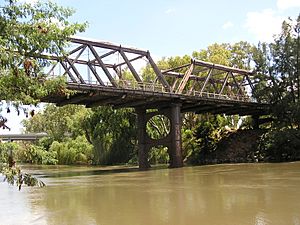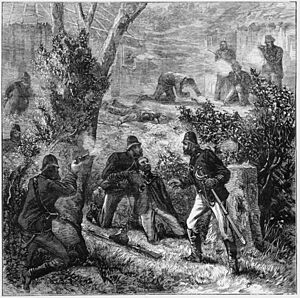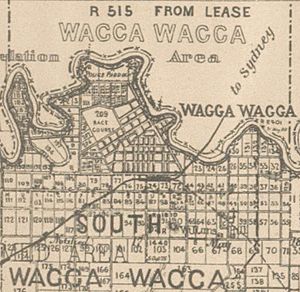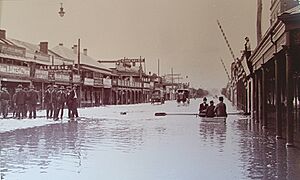History of Wagga Wagga facts for kids
The history of Wagga Wagga tells the story of how this important city grew from a small crossing point on the Murrumbidgee River into the biggest city in the Riverina region of New South Wales, Australia.
Contents
First People: The Wiradjuri
The first people to live in the Wagga Wagga area were the Wiradjuri people. The word "Wagga" from their language was once thought to mean "crow". To make a word plural, the Wiradjuri people would repeat it. So, 'Wagga Wagga' was believed to mean 'the place of many crows'. However, other meanings for 'wagga' include 'to dance, slide, or grind'.
In 2019, Wagga Wagga officially changed its Aboriginal meaning to 'dance and celebrations'. This new meaning was included in the city's first plan for reconciliation. The Wiradjuri word "Wagga" has always meant dance or celebration, not crows. Wiradjuri people continue to have a strong connection to the Wagga Wagga area today.
Early European Arrivals
The first European explorer to visit the future site of Wagga Wagga was Captain Charles Sturt in 1829. He was exploring along the Murrumbidgee River. Wiradjuri guides helped Sturt and his team on their journey.
The first European settler in the area was Charles Tompson, a former convict. He and his family started a farm called 'Eunonyhareenyha' on the north side of the river in 1832. Soon after, another former convict, George Best, started the 'Wagga Wagga' farm on the south side. This farm was named after the Aboriginal word for a waterhole where crows gathered.
More settlers arrived, all of them living on the land without permission. By 1836, the government started a system to license these settlers.
As more Europeans moved onto Wiradjuri lands, problems began. Aboriginal groups tried to protect their land and attacked the settlers' animals and workers. The settlers fought back. Over time, the Wiradjuri people faced many challenges, including new diseases like tuberculosis and smallpox. While they kept much of their culture, they lost their traditional lands and way of life.
As the number of settlers grew, people needed a local court. The closest courts were far away. In 1847, Wagga Wagga became a place for holding small court sessions. This helped keep law and order in a large area. A courthouse was built near the river crossing, where a small village began to form. This village had a blacksmith's shop and a hotel. A post office opened in 1849, and later that year, the town was officially marked out and named a village.
Building a River Crossing
In 1859, local people formed a group to build a bridge over the Murrumbidgee River. They first considered a pontoon bridge (a floating bridge). However, experts from the government disagreed. The committee then decided to build a pile bridge (a bridge supported by posts). When the government refused to help pay, the local committee decided to fund it themselves.
On August 23, 1860, a company was formed to build and maintain the bridge. The New South Wales Parliament passed a law in 1861 to create the Wagga Wagga Company Bridge. This law allowed the company to charge a toll (a fee) for people to use the bridge. The company had to borrow money because many people were worried the bridge might be washed away by floods. The bridge was finished in October 1862. It was about 91 meters long and 7 meters wide.
In 1884, the New South Wales Government bought the bridge for the public. Tolls stopped on February 29, 1884. By the 1890s, more people were using the bridge. Its wooden parts were getting old and it was in danger of collapsing. The local Member of Parliament, James Gormly, asked the government to replace it. The Wagga Wagga Company Bridge served the public for 33 years and was taken down in 1895.
In 1895, the Hampden Bridge, a truss bridge (a bridge with a framework of triangles), was built across the Murrumbidgee River. On August 16, 2006, the Hampden Bridge was closed because it was unsafe. It was taken down starting in June 2014. Many people felt the bridge was important to the city's history and discussed whether it should be demolished.
Important Historic Places
Wagga Wagga has several places listed for their historical importance. These include:
- Botanic Gardens Site (BGS), Baden Powell Drive: Mobile Cook's Galley, Museum of the Riverina
- Main Southern railway: Wagga Wagga railway station
Law and Order in Early Wagga
As Wagga Wagga grew, it became a target for famous bushrangers (outlaws). In 1863, the Wagga police magistrate, Henry Baylis, was held up by Mad Dog Morgan. Later, when Baylis and police officers found Morgan, the magistrate was shot and injured.
Captain Moonlite was released from prison in 1879. He arrived in Wagga looking for work at Wantabadgery Station. When he was refused work, Moonlite and his five friends held 39 people hostage at the station. One hostage escaped, and three police officers from Wagga arrived. They had a shootout with the gang. Moonlite and his gang escaped but were caught at another nearby property when police from other towns arrived. Moonlite was later executed for his crimes.
Ned Kelly's younger brother, James Kelly, also got into trouble. After serving four years for stealing cattle, he was sentenced in 1877 at the Wagga courthouse to ten years in prison for stealing two horses. Unlike his older brother, James lived a good life after he was released and lived until 1946.
Joining the Nation and World Wars
In the late 1800s, Wagga Wagga, like much of rural Australia, was proud of its connection to the British Empire. Many volunteers from Wagga Wagga joined military units sent to conflicts like the Mahdist War in Sudan in 1885 and the Second Boer War in South Africa in 1899. Even with these strong ties, a feeling of national identity was growing in Wagga Wagga.
Most people in Wagga Wagga and the Riverina region supported the federation of the Australian colonies. A big reason was the idea of free trade between the colonies. Many politicians spoke in Wagga Wagga about supporting Federation. From 1898, some residents suggested Wagga Wagga as the site for the new national capital. They pointed out its location, which was about halfway between Sydney and Melbourne, and its good water supply. Even though Wagga Wagga wasn't chosen, its residents voted strongly for federation in the 1899 referendum.
When World War I started, many men from Wagga Wagga volunteered to serve. The town was the starting point of the "Kangaroo March." This was one of several marches in New South Wales where groups of recruits walked towards Sydney. Along the way, they encouraged men in other towns to join them and enlist in the Australian Imperial Force. On December 1, 1915, 88 recruits left Wagga Wagga. They were cheered on by a large crowd and a band. One of the marchers was John Ryan, who later won the Victoria Cross for his bravery in 1918. The march stopped in towns like Junee and Yass, ending in Campbelltown with over 220 recruits. The local Rugby league team, Wagga Kangaroos, was named after this march.
During the war, there were two big debates about conscription (forcing people to join the army). These debates in 1916 and 1917 caused deep divisions in Wagga Wagga. Farmers, business people, and professionals generally supported conscription. Working-class people, often Catholic, tended to be against it. Both referendums were narrowly defeated across Australia. Wagga Wagga voted for conscription in 1916 but against it in 1917.
Between the World Wars
Soldiers returning from World War I brought the "Spanish flu" epidemic with them. This sickness spread around the world and briefly stopped the town. Some land around Wagga Wagga was set aside for soldiers returning from the war. However, many faced huge problems because the land was poor, they lacked farming experience, and couldn't easily sell their crops. Many left the land after years of hard work. After some debate, the Victory Memorial Gardens were built in 1927 to honor those who served.
Throughout the 1920s, the New South Wales Government improved roads and railways in the region. Wagga Wagga became part of a new telephone link between Melbourne and Sydney. A new Post and Telegraph office was built, which was one of the largest in regional Australia. The town's population grew to 11,631 by 1921. Much of this growth happened on higher ground south of the railway tracks. A temporary suburb of tents and huts, called "Tent Town," grew along the river. This provided homes for poorer residents. In 1922, the town got electricity, and by 1928, hydro-electric power from Burrinjuck Dam was available.
The Great Depression (a time of severe economic hardship) greatly affected Wagga Wagga. The town had programs to help unemployed people, mainly by improving public works. However, poverty was widespread, and "Tent Town" became very crowded as people couldn't afford rent. The depression led to the formation of the "Riverina Movement." In early 1931, this movement held rallies across the Riverina, with a big meeting in Wagga Wagga on February 28, 1931. The meeting asked the government to help local producers or hold a vote to see if the Riverina should become a separate state. The movement faded away after the Premier, Jack Lang, was dismissed in 1932 and the economy improved.
World War II and After
When World War II began, Wagga Wagga became a key place for Australia's defense. Royal Australian Air Force bases were built at Forest Hill in 1940 and Uranquinty in 1941. A large Australian Army camp was built at Kapooka in 1942. A year later, 8,000 troops were training there, making Wagga feel like a military town.
Sir Thomas Blamey, who was born in Wagga Wagga, became Australia's highest-ranking officer during the war. Another Wagga Wagga native, John Hurst Edmondson, was the first Australian to win the Victoria Cross in World War II for his brave actions.
On April 17, 1946, Wagga Wagga was officially declared a city. It grew steadily after the war. New suburbs like Turvey Park, Mount Austin, and Kooringal were developed, including over 1,200 Housing Commission homes. In the 1960s, residential growth spread to areas like Tolland and Lake Albert. As the city grew south, the main shopping area also moved south to the Baylis Street end. The Sturt Mall, built in 1979, was part of this growth. The northern end of the central business district slowly became less busy. To encourage more industries in Wagga Wagga, the City Council developed industrial areas. These included places for service industries, general industries, and agricultural processing in a new industrial estate in Bomen.
In the 1950s, the defense bases in Wagga Wagga became important again. The Army camp at Kapooka reopened in 1951 as a recruit training center, and it still trains new soldiers today. RAAF Base Wagga at Forest Hill also expanded, with training for defense aircraft technicians starting there in 1969.
A teachers' college was established in Turvey Park in 1947, and an agricultural college in 1949. In 1971, after the Wagga Wagga community pushed for a university, the teachers' college became the Riverina College of Advanced Education. It moved next to the Wagga Agricultural College, and the two combined in 1975. In 1989, this college joined with another college in Bathurst to become Charles Sturt University. The Wagga Wagga Base Hospital became the main hospital for southern New South Wales, and a new seven-story hospital was built in 1963.
Flooding was a common problem for Wagga Wagga, with major floods happening many times. After the 1956 floods, the City Council built a levee (a protective wall) to protect the city area on the south flood plain. This levee was finished by 1962 and protected against large floods. However, North Wagga Wagga was not protected. Attempts were made to make North Wagga Wagga residents leave their homes. But the residents resisted, and a sign appeared saying, We Shall Not Be Moved. By the 1970s, the Council finally agreed to the residents' demands. A levee was built to protect North Wagga Wagga by 1982, though it was a smaller one. In 1981, the New South Wales government combined Wagga Wagga City Council with two nearby areas to form the new City of Wagga Wagga local government area, which covers a large area of 4,886 square kilometers.
See also






